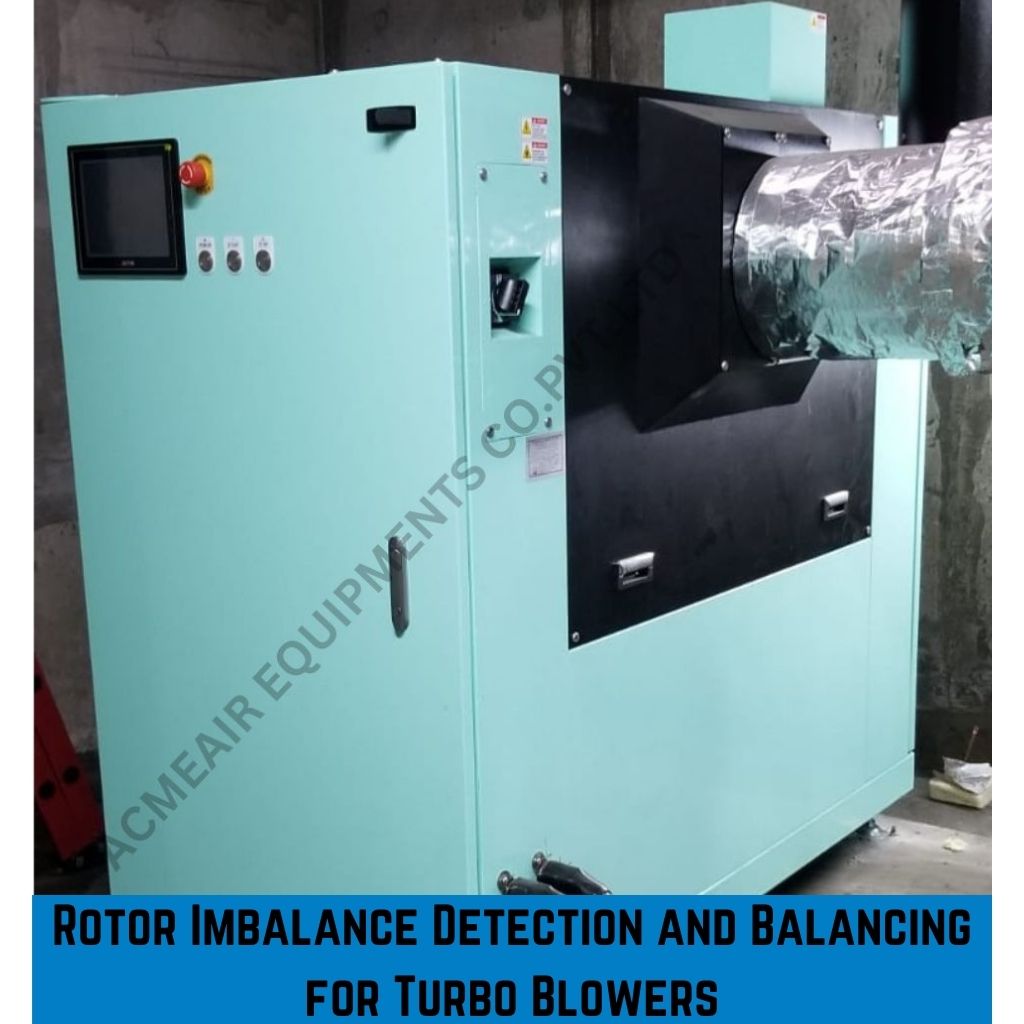Table of Contents
Objective:
The objective of this article is to provide a detailed guide on how to balance and align turbo blower components to ensure vibration-free operation. Vibration is one of the most common causes of premature wear, energy inefficiency, and equipment failure in turbo blowers. Proper alignment and balancing are critical for ensuring that the turbo blower runs smoothly, efficiently, and with minimal downtime. This article will cover the importance of balancing and alignment, the step-by-step procedures involved, and how regular maintenance can extend the life of your turbo blower.
Why Balancing and Alignment Are Critical for Turbo Blowers
Turbo blowers are designed to provide high airflow at constant pressures, making them essential components in industries such as pneumatic conveying, wastewater treatment, and HVAC systems. However, when the components within the blower are not properly aligned or balanced, they can introduce vibrations that lead to several issues:
- Excessive wear and tear on bearings, seals, and rotors.
- Increased energy consumption due to inefficient operation.
- Inaccurate airflow or pressure output, leading to system inefficiencies.
- Premature failure of components, resulting in costly downtime.
Proper balancing and alignment reduce these risks, ensuring that the blower operates smoothly, efficiently, and with a longer lifespan. Below is a step-by-step guide to achieving vibration-free operation in turbo blowers.
Step-by-Step Process for Balancing and Aligning Turbo Blower Components
Safety First
- Disconnect Power: Ensure the blower is powered off and safely locked out to prevent accidental startup during maintenance.
- Personal Protective Equipment (PPE): Wear appropriate PPE such as gloves, safety goggles, and hearing protection to avoid injury.
- Isolate the System: Make sure the turbo blower is isolated from any pressurized air or gas lines before starting maintenance.
Inspect for Visual Issues
- Visual Inspection: Before starting the alignment or balancing process, conduct a thorough visual inspection of the blower components. Look for any visible damage, wear, or looseness in parts such as rotors, shaft couplings, bearings, and mounting pads.
- Check for Imbalance Indicators: Look for signs of uneven wear, oil leaks, or abnormal noise when operating the blower, as these may indicate imbalance or misalignment.
Balancing the Turbo Blower Rotors
Imbalance in the blower rotors can be a significant source of vibration. The key steps in balancing include:
Measure Rotor Imbalance:

- Rotor imbalance can be detected using a vibration meter or accelerometer. These tools can detect the frequency and amplitude of vibrations during operation, which can indicate imbalances.
- Perform a vibration analysis on the blower when it is running at full speed to determine if there is any imbalance.
Balance the Rotors:
- Use a dynamic balancing machine to balance the rotors. This machine allows for precise weight adjustments on the rotor to reduce imbalance.
- If dynamic balancing is not available, a simpler static balancing can be done by attaching small balancing weights to the rotor in specific locations to counteract the imbalance.
- After adjusting, re-check the rotor’s performance with the vibration meter to ensure the imbalance has been corrected.
Aligning the Turbo Blower Components
Misalignment of the blower’s shaft, rotors, or couplings can lead to vibrations, noise, and wear. The alignment process includes:
Check Shaft Alignment:
- Laser Alignment Tools: Use laser alignment tools or a dial indicator to measure the shaft alignment between the motor shaft and blower shaft. These tools provide precise measurements of any misalignment.
- Correct Misalignment: Adjust the couplings or reposition the motor or blower components to ensure that the shafts are aligned within the manufacturer’s recommended tolerances.
Check Rotor Alignment:
- Ensure that the rotor’s axis is aligned properly with the housing and that there is no axial or radial misalignment.
- Adjust rotor positioning: In some cases, the rotor may need to be moved slightly to ensure it is correctly aligned with the blower casing. This ensures the rotor rotates freely and without friction.
Tighten Couplings and Fasteners:
- Ensure that all couplings, bolts, and fasteners are securely tightened. Loose fasteners can cause vibrations and lead to misalignment, which affects blower performance.
Check and Adjust Bearings
Bearings are key components that support the rotor and allow it to rotate smoothly. Misalignment or imbalance can lead to excessive wear on bearings, causing noise, heat buildup, and premature failure.
Inspect Bearings:
- Visually inspect the bearings for any signs of wear, misalignment, or lubrication issues.
- Check the bearing housings to ensure they are properly aligned with the shafts.
Lubricate Bearings:
- Ensure the bearings are adequately lubricated with the correct lubricant recommended by the blower manufacturer. Over-lubrication or under-lubrication can cause problems with smooth operation.
- Check that the oil seals are intact and there are no oil leaks around the bearings.
Recheck System Performance
Once the blower has been balanced and aligned, it’s important to verify its performance:
- Vibration Testing: Run the blower at full speed and measure the vibration levels with a vibration meter. The goal is to ensure that the vibration levels are within the acceptable range for your system.
- Monitoring: Use monitoring tools such as vibration analysis systems to continuously monitor vibration levels during operation and detect any future misalignment or imbalance.
- Listen for Abnormal Noises: Any abnormal sounds during operation may indicate a problem with alignment or balancing. Ensure the blower operates quietly and smoothly.
Best Practices for Ongoing Maintenance and Monitoring
- Regular Vibration Analysis: Perform regular vibration analysis during scheduled maintenance to ensure that any imbalance or misalignment is detected early.
- Monitor Temperature: Keep an eye on the operating temperature of the motor, bearings, and other key components. Abnormal temperatures can indicate mechanical issues or poor alignment.
- Scheduled Alignment Checks: Even if no problems are noticed, make periodic checks to ensure that the blower’s components remain aligned.
- Lubrication Maintenance: Regularly check lubrication levels and replace old oil or grease to ensure smooth operation and prevent wear.
FAQs
How do I know if my turbo blower is misaligned?
Common signs of misalignment include excessive vibration, unusual noise, and higher-than-normal bearing temperatures. Using laser alignment tools or a dial indicator can help detect even slight misalignments.
How often should I perform balancing and alignment on a turbo blower?
It is recommended to perform balancing and alignment checks at least once every six months, or more frequently depending on the blower’s usage and operating conditions. Regular monitoring is also important if the blower experiences high vibration levels.
Can I perform the alignment and balancing myself, or do I need professional help?
Basic alignment and balancing can often be done by trained personnel using proper tools such as laser alignment devices and vibration analyzers. However, for more complex systems or if you lack the tools, consulting with a professional technician may be necessary.
What could happen if the blower components are not properly aligned?
If the components are misaligned, it can lead to vibration, bearing damage, increased energy consumption, and premature component failure, which can significantly reduce the efficiency and lifespan of the blower.
What tools are needed for balancing and alignment of a turbo blower?
The primary tools include laser alignment systems, dial indicators, vibration analyzers, tachometers, and lubrication equipment. Additionally, balancing machines can be used to correct rotor imbalances.
Conclusion
Proper balancing and alignment are critical for ensuring the efficiency, reliability, and longevity of a Tri-Lobe Turbo Blower. Misalignment or imbalance can lead to excessive vibration, premature wear, and reduced performance, which can impact the entire pneumatic system. By following the outlined steps, including visual inspections, rotor balancing, bearing checks, and alignment adjustments, operators can ensure that the turbo blower operates smoothly, with minimal vibration, and at maximum efficiency. Regular maintenance and monitoring will extend the life of the blower and reduce the likelihood of costly repairs or downtime.
About Author

CEO
Mr. Vishwesh Pardeshi is the CEO of Acme Air Equipments Company Pvt. Ltd., an industrial and engineering goods manufacturing company based in Ahmedabad, Gujarat (India). He has taken over the responsibility from founding Partners and Directors of the Company, and is now leading a talented group of professionals since 2020 by bringing in vast industrial and management expertise. By qualification, he holds a Bachelor Degree in Mechanical Engineering and also holds a MBA degree from reputed institutes. Under his leadership, the Company has successfully executed prestigious projects by delivering high quality and world class products from a state of the art manufacturing facility which combines CNC-enabled precision manufacturing and strong after sales support. In line with the Vision, Mission and Core Values of the Organization, Mr. Vishwesh Pardeshi continues to drive Quality, Reliability and Global Expansion at Acme Air Equipments Co. Pvt. Ltd.









